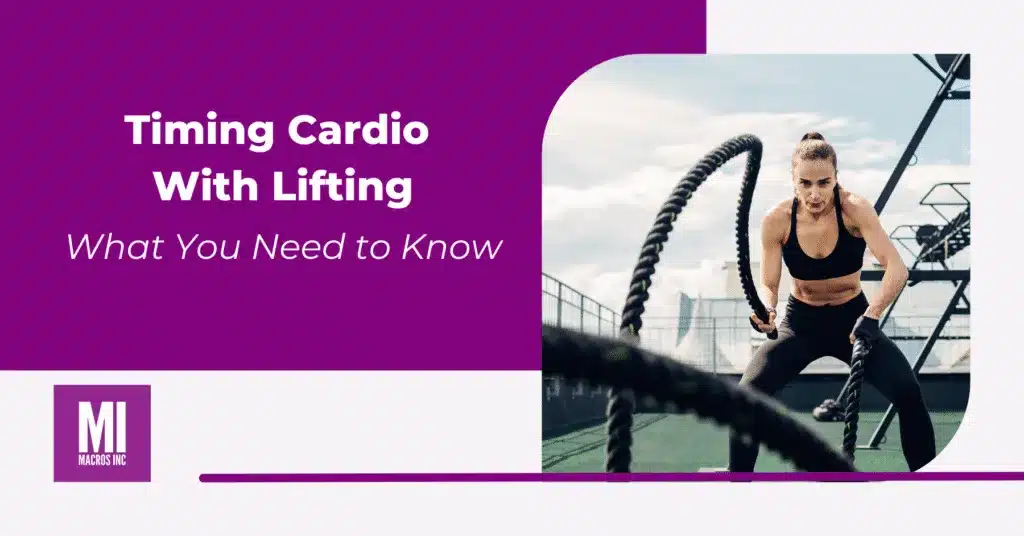Cardio timing in relation to lifting is a topic filled with myths and misconceptions. If your primary goal is size, strength, or power, but you also want to incorporate cardio for fat loss, general health, or recovery, it is important to understand how to structure your training for the best results.
Let’s break it down.
Jump to a Topic
Timing Cardio with Lifting: What You Need to Know
The Physiology of Timing Cardio and Lifting
When you lift weights, your body initiates several adaptations:
- Your nervous system starts recovering and upgrading its abilities.
- Your muscular system begins signaling for growth through pathways like mTOR.
- Muscle growth signaling peaks within a day after training and declines over the next few days.
When you do cardio, your body sends very different signals:
- Cardio engages pathways like AMPk, which are involved in fuel metabolism and muscle endurance.
- AMPk can suppress mTOR activity, which can interfere with muscle growth.
- Cardio also burns nutrients that could be used for muscle recovery and growth.
This means that if your main goal is muscle growth, you should avoid cardio in the hours immediately after lifting and be mindful of how cardio affects nutrient availability.
General Recommendations for Timing Cardio
1. If Your Sport Requires Power, Minimize Cardio
If you are in a sport where power is key, such as weightlifting or gymnastics, cardio may do more harm than good. Cardio can lead to muscle fiber transitions that reduce power output and alter neural adaptations necessary for strength and speed. If you are trying to lose fat, adjusting your diet and lifting volume is often a better choice than adding cardio.
2. Space Cardio and Lifting Apart When Possible
- Ideally, finish cardio at least 3 hours before lifting.
- If doing cardio after lifting, wait at least 6 hours before starting.
- The further apart your lifting and cardio sessions are, the better.
In between sessions, prioritize protein and carbohydrate intake to help with recovery.

3. If Combining Cardio and Lifting in the Same Session
- For Strength Training: Do cardio after lifting. Pre-lifting cardio can reduce strength output and make it harder to generate high levels of force.
- For Hypertrophy (Muscle Growth): Consider doing cardio before lifting to avoid interfering with anabolic pathways after weight training. Fatigue may affect performance, but volume-based training is less reliant on absolute strength.
Adjusting Based on Your Response
- If doing cardio before lifting does not affect your performance, it is fine to keep it before your workout.
- If cardio negatively impacts your lifting by reducing your strength or endurance, move it to after your session or to another part of the day.
- Ideally, aim for separate cardio sessions if scheduling allows.
Does Doing Cardio After Lifting Burn More Fat?
A common claim is that doing cardio after lifting helps burn more fat because it depletes glycogen first. However, research shows that timing does not significantly impact fat loss.
Fat loss is determined by total calorie expenditure over time, not by whether you do cardio before or after lifting. The most important thing is to fit cardio into your schedule in a way that does not negatively impact your training quality.
Choosing the Right Type of Cardio
1. MISS (Moderate Intensity Steady State Cardio)
- Best for max weight loss and general health.
- Includes activities like running 5 miles at an even pace.
- Burns the most total calories but can increase fatigue and muscle loss risk for highly trained individuals.
- Best choice if time is not an issue.
2. HIIT (High Intensity Interval Training)
- Ideal for those short on time.
- Alternates between sprint-level intensity and recovery periods.
- Burns a high number of calories in a short period but causes significant fatigue.
- Best for fat loss if time is limited but should be limited to 4 hard sessions per week.
3. LISS (Low Intensity Steady State Cardio)
- Includes walking on an incline treadmill or slow stepmill sessions.
- Burns the least calories per session but does not interfere with muscle recovery.
- Great for bodybuilders, powerlifters, or anyone wanting to retain muscle while cutting.
- Best for those who want low-impact fat loss with minimal fatigue.
Wrap Up
The best cardio timing depends on your goals, training schedule, and individual response. The key takeaways are:
- Avoid doing cardio immediately before or after lifting if muscle growth is your priority.
- Space cardio 3-6+ hours apart from lifting when possible.
- Prioritize strength performance by doing cardio after lifting.
- Choose the right type of cardio based on your goals and recovery needs.
If you are serious about both lifting and cardio, experiment with different setups and track your results. Adjust based on performance and recovery, and you will find the approach that works best for you.
Try our nutrition coaching, for free!
Be the next success story. Over 30,000 have trusted Macros Inc to transform their health.
Simply fill out the form below to start your 14-day risk-free journey. Let's achieve your goals together!

